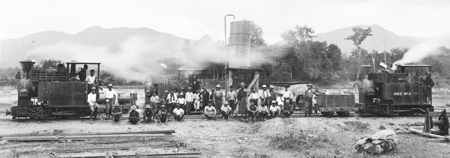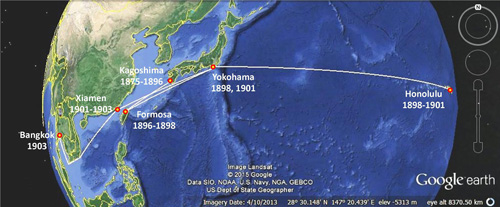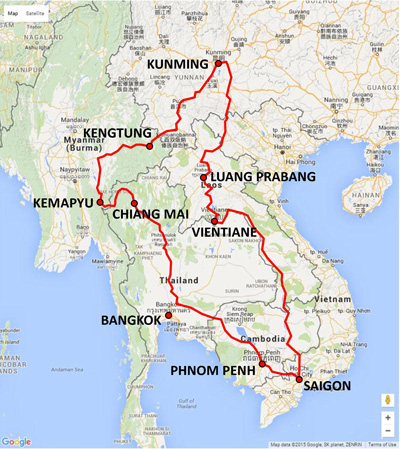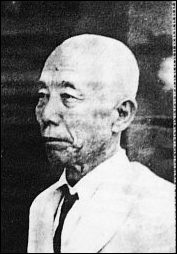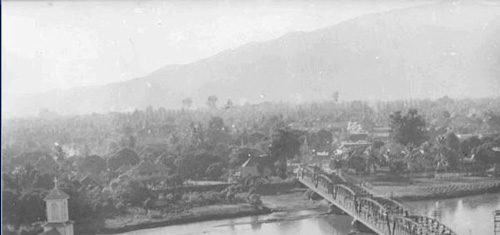1901: On the assumption that Tanaka’s time in Hawaii was based on a three year Dekasegi contract, and he and his employer complied with it,1 he would have departed Hawaii in July 1901.2 He indicated to the Kagoshima press that in that year he moved on to Xiamen 3 It was a Chinese “treaty port” opened in 1842 by the Treaty of Nanking which had resolved the First Opium War between Britain and China. An island in the delta of the Jiulong River, it provided access to the Chinese mainland and was only 225 km west of Formosa.4 As an international trans-shipping point, it would have had a far more sophisticated populace than Formosa, with technology likely available for expanding Tanaka’s photographic skills. But, as in Formosa, the Japanese there were enduring a substantial hostility from Chinese inhabitants.5 Perhaps they anticipated, correctly, that Japan saw Xiamen as important to its Southern Expansion Doctrine,6 and would eventually occupy it, which it did in 1938.7 What Tanaka did in Xiamen is unrecorded.
1902: Tanaka left Xiamen and arrived in Bangkok.8
An alternate, more benign, explanation for Tanaka’s actions from 1896 through to 1902 might be that he was just looking for a new place to start a business; this could be supported by Wikipedia‘s article about the IJA’s secret police, the Kempeitai9
In the period from about 1895 to 1941, Japan encouraged emigration of its citizens to nations bordering the Pacific Ocean . . . The position taken by Tokyo was that [they] held dual citizenship, with loyalty to Japan, and loyalty to the Emperor first and foremost.
1902-1929: Tanaka began a twenty-seven year period in which he apparently worked very successfully as a photographer in Thailand, as evidenced by the numerous “Tanaka” photos in various collections around Chiang Mai.10
 1903: In Bangkok, Tanaka apprenticed himself to Robert Lenz, an accomplished photographer from Germany,11 who operated a photo shop and amongst his clientele numbered royalty from all over Thailand, starting right at the top with King Chulalongkorn.12 Some of Lenz’s photos are still marketed today:13
1903: In Bangkok, Tanaka apprenticed himself to Robert Lenz, an accomplished photographer from Germany,11 who operated a photo shop and amongst his clientele numbered royalty from all over Thailand, starting right at the top with King Chulalongkorn.12 Some of Lenz’s photos are still marketed today:13
Tanaka, demonstrating a notable savoir faire, fit right in and seemed to have befriended the cream of Thai society.14
1904: While Tanaka was in Bangkok, the Russo-Japanese War began on 08 February, nominally over control of Manchuria and Korea. Japan wanted Russian recognition of its control over northern Korea, while Russia wanted to retain control of Port Arthur, its only warm water port on the Pacific (and the railway to it).15
1905: The Russo-Japanese War ended 05 September with the Treaty of Portsmouth. “The complete victory of the Japanese military surprised world observers.” 16 Japanese military and citizens continued to be lulled towards a sense of invincibility.
Apparently unaffected by the war, Tanaka left Lenz and joined a fellow Japanese, Kaishu Isonaga, in operating Isonaga’s photo shop in Bangkok which had started in business in 1895. Their working together is evidenced in this photo mount dated 20 November 1905:17 18
Note that while Isonaga was the senior of Tanaka by 15 years in a society which venerated age, Tanaka’s name came first in the upper extract and above Isonaga’s in the lower extract. The reason for this is not clear.
1907: Tanaka returned to Kagoshima, Japan to visit his family, and his return was covered by a local newspaper. His time in Kagoshima seems to have been notable primarily for his having spent so little time there:19 he was said to have been busy in Tokyo purchasing photo supplies for himself, plus music and movie film for Thai friends. While in Tokyo, he became ill with empyema, went to hospital where he recovered, and, in the process, had an affair with a nurse, which resulted in a child. The couple were married in June. Tanaka however was seen by his family as concentrating on collecting supplies for his shop in Siam, and then leaving for Siam in December. His son was born a month after he left, in January 1908; Tanaka never returned to Japan and never saw the child.20 A necessary digression:
It would be unfair here to leave Tanaka with an appearance of raw heartlessness for his actions in this situation: his actions could evidence an individual responding to a higher clingstone religious, but rather patriotic. If so, it could imply that Tanaka did have an assignment, a lifetime assignment, representing the interests of his country overseas. Tanaka did make arrangements for the son to be raised in his parents’ household and his father extended that arrangement to include his daughter-in-law.21 Tanaka did keep in touch with his Japanese wife and son, and regularly transferred money to them.22 He is said to have gotten the boy a job in a trading company in Tokyo, where he worked in the “Thailand Room”.23 A niece of Tanaka later noted that the son had been trying to get transferred to a position in Thailand,24 when he had been killed in a freak railway accident in 1954.25 On receiving news of his son’s death, Tanaka was said to have been badly shaken.26
1909: After six years in Bangkok and befriending visiting royals from around Siam, Tanaka left Kaishu Isonaga to accept an invitation from the Prince of Lampang to open a photo studio in his province, which was prospering with its teak harvesting industry.27 Rail connections to the far north of Siam were still under construction, so Tanaka went as far as Nakhon Sawan by rail; from there he continued by boat on the Chao Phraya and then the Wang River to Lampang.28
1910: Tanaka’s former partner, Kaishu Isonaga, wanting to travel, turned his photo shop in Bangkok over to a Shozo Hatano, and left. Hatano had worked there since perhaps 1905, and therefore knew Tanaka, who had left in 1909.29 Curiously, with Tanaka gone in 1909 and Isonaga in 1910, the two would still be listed as principals in “K Isonaga Photographers” in The Siam Directory 1912.30
1911: After working in Lampang for two years as the sole photographer there,31 Tanaka was invited to set up shop in Chiang Mai by a Dr Edwin Cort from that town;32 he accepted, lured by a larger customer base and a prosperity greater than in Lampang.33 The Northern Rail Line, still under construction, again proved a hindrance to his travels, so Tanaka walked to Chiang Mai, with his equipment trailing him, carried on horseback.34 He set up shop in the Wat Gate area of Chiang Mai, with the river to his back;33 exploring entrepreneurship, he also set up the first cinema in Chiang Mai on Wichayanon Road near the present day President Hotel. His photographic enterprise flourished, and he became affectionately known as “Naiharn Tanaka”, ie, owner of the Tanaka photo shop.35 The cinema eventually failed with the opening of the Tantawan Theater at the Chang Klan-Loi Kroi intersection.36
Tanaka was an avid sportsman, proficient in tennis and golf.14 His skills, coupled with his naturally gregarious nature, enabled him to indulge in those sports as a guest at Chiang Mai’s Gymkhana Club. His participation was sufficiently frequent that some in the surrounding community assumed that he was an ordinary member.37 Club rules however excluded him since he was not of British, European, nor American nationality (ie, Caucasian).38 That limitation also apparently precluded him from participation in the various inter-club competitions, from mention in the club minutes, or official photos (though he probably took them).39
1914: Tanaka married Changdee Ping’yo, who lived in Lamphun.40 Shu Hatano, who would become Tanaka’s son-in-law 25 years later, volunteered an insight about foreigners who married Thais: Siamese nationality was required to own land in Siam (a requirement which continues today) and it was common practice for foreign males, including Japanese, to marry Thai women so as to be able to hold land. Hatano himself may have used the same ploy, however Matsumoto’s wording on this tack is ambiguous, and probably tactful:41 this same Shu Hatano was Matsumoto’s primary information source in Thailand 75 years later.
Subsequently, Tanaka acquired control of land adjacent to the First Church of Christ on which he built a permanent two storey house and shop:42

Behind the house, Tanaka built a photo studio with a north facing skylight to catch light from the northern sky. Such light is still favored today by purist portrait photographers.43 However, in Tanaka’s early days in Chiang Mai, the skylight was not a luxury, but rather a necessity: there was no mains power available in Chiang Mai.44

A son was stillborn to the couple.45
Shozo’s brother, Shu Hatano, 16 years younger, and Tanaka’s future son-in-law, left Japan and joined Shozo at his invitation to work in the photo shop in Bangkok given to him by Kaishu Isonaga.46
1915: On 20 August, a daughter was born to the Tanaka couple. She was named Cheiko in Japanese and Kumpoon in Thai.47)
1917: Tanaka and Changdee divorced. The daughter stayed with Tanaka.48 Changdee returned to Lamphun and later married a Thai.45
1918: Apparently hired by the Bombay Burmah Trading Company (BBTC) to photograph a company logging facility around Mong Hang, Burma (~N20°03.6 E98°56.3), Tanaka recorded an unnavigable underground river passing through a grotto named Gnoke (N20°09.7 E98°54.1), with an elaborate 12 km land route workaround ending in a chute dropping about 300 m into the Hang River.49
1921: A Japanese botanist doing field work in Southeast Asia, Soda Bunzo (早田文蔵), was recorded as having been hosted by Tanaka during his stay in northern Thailand.50 Bunzo would have been enjoying the support of an informal but active network that linked Japanese expatriates everywhere (all nationalities of any significant number could rely on such networks for support in foreign countries).
1923: Tanaka recorded the arrival of the first aircraft in Chiang Mai:51

1927: Tanaka, in white shirt and dark tie, was pictured on a holiday outing with various government officials and their friends and families at “Pha Ngeub” on Doi Suthep:52
Around 1927, Tanaka was apparently commissioned by BBTC to photograph the company’s transport activities in its Li-Soem Logging Concession. His work included one of his more famous photos, that of railroad crews and equipment in BBTC’s Li-Soem railroad yard:53
During this period, Tanaka capitalized on his photographic efforts, marketing some of his photos as postcards:54
Last Updated on 29 February 2024
- Some contract workers escaped the plantations to live in towns and others somehow traveled to the mainland; others after three years refused to return to Japan and moved into the towns (Ogawa, p 9; Hawaii: Life in a Plantation, ibid).[↩]
- No other information from US Immigration is currently available.[↩]
- Matsumoto, p 229, specified 1901, while Boonserm, p 53, specified 1898. Matsumoto based his date on the Kagoshima newspaper article.[↩]
- Google Earth Scale tool.[↩]
- Matsumoto, p 192.[↩]
- Wikipedia: Nanshin-ron and, by that time, the Greater East Asia Co-Prosperity Sphere (both links confirmed 12 Aug 2015).[↩]
- Wikipedia: Xiamen, link confirmed 12 Aug 2015.[↩]
- Matsumoto, p 229; Boonserm, p 53, wrote 1898.[↩]
- Accessed 29 Aug 2011. The sentences are no longer present.[↩]
- Tanaka’s photos are now displayed in hotels, restaurants, hospitals, wats, government offices, etc. As many of his photos as there are around, that number was reduced when photos borrowed by Chiang Mai’s Kong Muang newspaper were lost when it folded in 1970 (Matsumoto, p 19). In addition, Boonserm recalls seeing Tanaka’s daughter “cleaning house” at the old photo shop after Tanaka’s death: she was dumping what she considered trash, which included old glass negatives, in the river in front of the shop. He stopped her and salvaged photos from the remaining trash, but he couldn’t recover what she had already pitched.[↩]
- Boonserm, pp 50-53; Matsumoto, pp 26-27; Anake, pp 567-580.[↩]
- Numerous Lenz photos of Chulalongkorn appear in Anake: pp 585-588, 595-597, 604.[↩]
- Or at least in the near past: Voyages en Photographie. Accessed 05 Aug 2011 (website not open in Sep 2015).[↩]
- Boonserm, p 53.[↩][↩]
- Wikipedia: Lushunkou District, link confirmed 12 Aug 2015.[↩]
- Quote from Wikipedia, Treaty of Portsmouth, accessed Aug 2011: text no longer present in 2015.[↩]
- Date per Matsumoto, pp 228, 229. Photo of photo mount at Wat Muen San, CIMG4941 of 23 Sep 2009; also Matsumoto, p 28.[↩]
- Extract from TeakDoor website 01 Sep 2011. Photo no longer on website, 2015.[↩]
- Matsumoto, p 126.[↩]
- Matsumoto, pp 122-136.[↩]
- ibid, pp 167, 194.[↩]
- ibid, p 73.[↩]
- bid, p 168.[↩]
- ibid, p 78[↩]
- ibid, pp 171-177.[↩]
- ibid, p 203.[↩]
- Boonserm, p 53. Matsumoto, p 27.[↩]
- Matsumoto, p 27: Hatano said the trip took a month. Boonserm, pp 47, 50: trip was by boat to Tak and by foot to Lampang, with a three month duration. Rail history in BR Whyte, The Railway Atlas of Thailand, Laos and Cambodia (Bangkok: White Lotus, 2010), p 22, indicates the rail line ended near Phitsanulok in 1909 which would tend to support Matsumoto’s version.[↩]
- Matsumoto, pp 17, 228; however, at another point, Hatano indicates that Shozo did not meet Tanaka until after he took over Isonaga’s shop (p 195).[↩]
- The Siam Directory 1912 (Bangkok: White Lotus, 2005), p 150. [added 25 Mar 2016][↩]
- Matsumoto, p 208.[↩]
- In 1911, Dr Cort was apparently working in Lampang though he had earlier worked in Chiang Mai (Robert Speer, et al, Report of Deputation . . . (New York: Board of Foreign Missions of Presbyterian Church, 1915), p 107); in 1915, he was appointed head of Chiang Mai’s McCormick Hospital (Shurtleff, William and Akiko Aoyagi, History of Soymilk . . . (Lafayette CA: SoyInfo Center, 2013), p 577); and in 1929, he was honored to be chosen to perform surgical procedures with Prince Mahidol, father of King Bhumibol (The Father of Modern Medicine and Public Health of Thailand) (both links confirmed 12 Aug 2015).[↩]
- Boonserm, p 53; Matsumoto, p 29.[↩][↩]
- Matsumoto, p 29.[↩]
- Boonserm, p 53; Matsumoto, p 195.[↩]
- Boonserm, p 51; Matsumoto, p 195.[↩]
- Boonserm in various discussions at his house during 2015.[↩]
- JC Shaw, The Chiengmai Gymkhana Club: 1898-1998 (Craftsman Press, 1997), p 34; though various influential Thais were carefully included.[↩]
- Shaw, ibid, pp viii-82.[↩]
- Boonserm, p 53; Matsumoto, p 229.[↩]
- Matsumoto wrote, quoting Hatano “Because there’s no other way, you get a Thai woman and have her buy property.” Whether that “Thai woman” was Tanaka’s daughter appears to have been carefully and tactfully sidestepped; however Hatano did note that “his” (Hatano’s) property was in the name of [one of Hatano’s] daughters (Matsumoto, p 21).[↩]
- Boonserm, p 53. Photo (cropped) from Payap Collection, no. 328 (v8 p12), dated 1953, by Boonserm. [↩]
- Prakel, David, Basics Photography 06: Working in Black & White (Lausanne: AVA, 2008), p 62.[↩]
- Electric power: Gymkhana Club records for 14 Sep 1931, note that a contract was signed for the installation of electricity (Shaw, ibid, p 45). The club was opposite the original generating plant operated by one of the logging companies; Tanaka’s shop was 1.5 km north of the club. Extract from photo from Payap Collection, no. 359 (v4 p31), dated 1953, by Boonserm.[↩]
- Matsumoto, p 87.[↩][↩]
- Matsumoto, p 15, 231.[↩]
- Matsumoto, p 229. The name was a combination of the Japanese Kamu meaning gold, and the Thai Ipon meaning Japan. (Matsumoto, p 87[↩]
- Matsumoto, p 229. The date is offered with a question mark. Hatano is quoted as saying that the marriage had unraveled in less than ten years (Matsumoto, p 86). The legal status of the couple’s relationship is not clear, but is relevant: the land for the photo shop would have been in Changdee’s name, and Tanaka could have been evicted with no recourse, unless the concept of usufruct existed in Thai law at that time and had been invoked.[↩]
- Photos discovered in London Archives by Oliver Backhouse [Item added 06 Nov 2016].[↩]
- 早田文蔵 (Soda Bunzo) (link confirmed 12 Aug 2015).[↩]
- Payap Collection, no. 444, dated 1923, by Tanaka.[↩]
- Payap Collection, no. 335 (v8 p5), dated 1927, by Tanaka, using timer (?).[↩]
- Photo from Oliver Backhouse private collection. Photo is also reproduced in Boonserm, p 50, but incorrectly identified there as a Borneo Co facility. The error becomes apparent when the initials on the locomotive on the right are seen to be BBC, ie, Bombay-Burmah Company: BBTC loco no 3 Pointed out by Oliver Backhouse, grandson of Evelyn van Millingen, who was Forest Manager in northern Thailand for BBTC, prior to WWII. [Item added 15 Apr 2016].[↩]
- Oliver Backhouse private collection. [Item added 16 Apr 2016] [↩]



